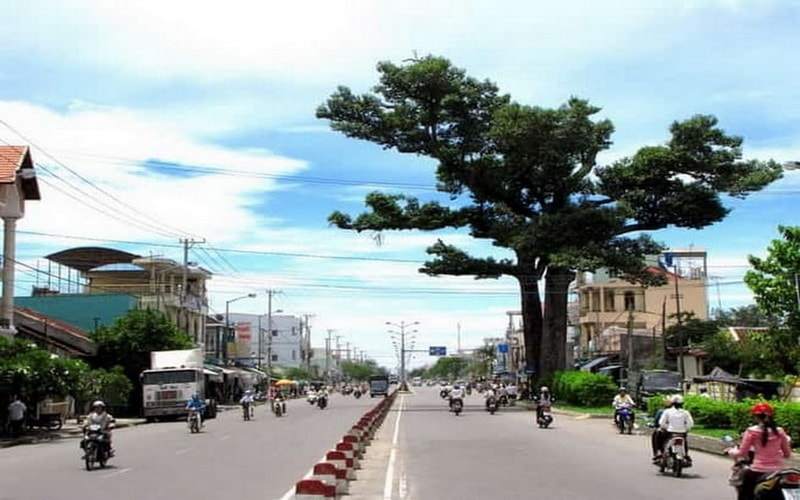History of oil trees is more than 350 years old in Khanh Hoa
11 kilometers south of Nha Trang, on the 23/10 road, right at the junction connecting with the provincial road to the north, there is an old double oil tree. The tree has cut many branches and has a few leaves, 30m high and has reached 15m canopy. This is an old double oil tree associated with the history of Khanh Hoa province and also has many anecdotes surrounding the tree.

Double oil tree over 350 years old Nha Trang Khanh Hoa
11 kilometers from Nha Trang to the south, on the 23/10 road, right at the junction connecting with the Hac route to the north, there is an ancient double oil tree. The tree has cut many branches and has a few leaves, 30m high and has reached 15m canopy. This is a double oil tree closely associated with the history of Khanh Hoa province and also has many anecdotes surrounding it.
According to many anecdotes about the double oil tree, the tree has two branches at the root that protrudes above Thien Ly road and is the largest oil tree in the ancient primeval forest in this land of Dien Khanh, Khanh Hoa province. In the 19th century, at that time, the population of this area was quite sparse and the road from Nha Trang to the city was mainly a narrow dirt road and only for carriages and people walking. Therefore, the forest above has quite a lot of trees. Until the end of the 19th century and the beginning of the 20th century, when the expansion of the road from Nha Trang was carried out and the population was increasingly dense, the forest gradually turned to residential areas and fields. The oil tree was then deep across the road and its luxuriant branches were kept as a symbol of the area.
Dien Khanh Khanh Hoa double oil tree
Determining the age of the double oil tree according to folklore, no one knows. But according to historical evidence, around 1793 when Dien Khanh citadel was being built, the oil tree was present. The next story is that around the beginning of spring in the year of the Dragon (1653), Lord Nguyen Phuc Tan ordered the governor Hung Ngoc Hau to start expanding the territory from Ca Pass to the north of Phan Rang River. During that dreamland period and when he came to Khanh Hoa, in that old forest, that extraordinary tall double oil tree was kept intact and has lived to this day.
Since then, the double oil tree has been associated with myths. It is said that it was originally a single-branched oil tree, but a thunderstorm and rain fell on the oil tree, causing it to split into two branches as it is today. However, after many visits to the double oil tree, we saw the double oil tree naturally because it is a two separate branch without any external influence.
With a wide field of vision, we can sometimes see this double oil tree from a wide distance, and when we see the double oil tree, it feels as if we are leaving home. Thanks to the shade of double oil trees, this place has surrounded this place into a bustling restaurant business area. The double oil tree is also a place to visit when people come to the old city or visit the ancient temples around the area. For people around the area, the double oil tree is quite sacred, so people set up a shrine under the tree to worship and pray for peace. Especially on the base of the double oil tree at a height of more than one meter there are vesicles. There are many vines living on the oil tree.
The story of Trinh Phong and the Double Oil Tree
The story of the double oil tree was closely associated with the young patriot who resisted the French. That's Trinh Phong. To the right of the double oil tree is Trinh Phong Temple.
Temple of Binh Tay General Trinh Phong Temple of Binh Tay General Trinh Phong
Historical site: Temple of Trinh Phong (in Dien An commune, Dien Khanh district)
The temple was built by the people here around 1886 to worship "Binh Tay General" Trinh Phong - the highest leader of the patriotic struggle of Khanh Hoa province when the French invaders in 1885-1886.
The relic was recognized as a national historical and cultural relic by the Ministry of Culture and Sports in 1991.
Trinh Phong Temple is not large and surrounded by many houses, so it is quite narrow even though it has undergone several renovations. The temple was built around the 90s of the 14th century. The temple door instead of facing the road turned to the North. At first, the temple worshiped the king, but when the king killed Binh Tay, general Trinh Phong, the French put his head on a double oil tree as a deterrent, so the villagers moved to Trinh Phong Temple and worshiped him. The temple dedicated to Trinh Phong and the double oil tree was recognized as a national historical relic in 1991. Currently, the temple still retains the two ordinations of the second emperors Thanh Thai and Khai Dinh. Every year, on the evening of March 16 (lunar calendar), a solemn ceremony was held at the shrine to commemorate the hero.
Trinh Phong is from Phu Vinh village, Vinh Thanh commune, Nha Trang. When Emperor Ham Nghi issued a decree of abdication (August 1885) when he was a general of the Nguyen Dynasty defending Dien Khanh citadel. He fought with the French under the red flag of "General Binh Tay" and gathered countless talents.
In early August 1886, the French army led by Colonel Lhermitte with heavy guns including 80 cannons and a team of mercenaries of about 300 people moved by land and water to capture Khanh Hoa to destroy the patriots. After Dien Khanh citadel was lost, Trinh Phong retreated to Heo Mountain to fight. But his strength was getting weaker and weaker, so at the end of August 1886 Trinh Phong was arrested by the French and buried in Hon Khoi (September 11, 1886). Trinh Phong's grave is buried in the middle of the family cemetery in Phu Vinh village, Vinh Thanh commune, Nha Trang.
BIRTHDAY BIRTHDAY OF DOUBLE OIL PLANTS
Restore the double oil tree Dien Khanh Khanh Hoa
Experiencing many marriages, but the idiom "Tangtian"
Other news
- Summary, Cooperatives associated with Grab Vietnam - 06/06/2025
- Latest 24h travel news - 18/04/2025
- History Nha Trang Vietnam - 06/09/2022
- The old city Yanqing Khanh Hoa - 06/09/2022
- Famous tourist destination in Vietnam - 06/09/2022
- Numberless of Nha Trang in Khanh Hoa - 06/09/2022
- Nha Trang City once upon a time! - 06/09/2022
- Top 10 most popular beautiful Bay Vietnam - 06/09/2022
- Stone churches 100 Years Nha Trang French Architecture Definition - 06/09/2022










